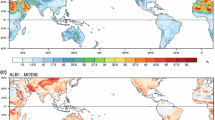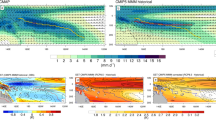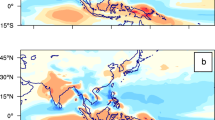Abstract
This study focuses on the relationship in global climate models between three features: the Saharan Heat Low (SHL), Sahel precipitation, and the Atlantic Intertropical Convergence Zone (ITCZ). Previous work showed that both coupled (CMIP) and uncoupled (AMIP) ocean/atmosphere models that place the SHL farther to the north are associated with increased precipitation across the Sahel. Further, the northward SHL placement is also associated with a northward shift in the Atlantic ITCZ in coupled CMIP models, but an eastward shift in uncoupled AMIP models. We perform three experiments with the Community Earth System Model to better understand relationships between these features. We find that when a northward-shifted Atlantic ITCZ is locally forced, there is no coherent response in the SHL and Sahel precipitation. However, when a northward-shifted Atlantic ITCZ is forced by altering the cross equatorial energy transport, the SHL shifts northward and Sahel precipitation increases, consistent with model biases. Finally, when the SHL strength is forced directly, there is a weak but robust increase in Sahel precipitation and a northward shift in the Atlantic ITCZ. The results of these experiments emphasize the important role of global scale energy biases on the simulation of West African climate, and show a possible feedback from West African climate onto the Atlantic ITCZ.

Adapted from Fig. 11 in Dixon et al. (2017). Copyright 2016 by the American Meteorological Society. Adapted with permission










Similar content being viewed by others
References
Adam O, Bischoff T, Schneider T (2016) Seasonal and interannual variations of the energy flux equator and ITCZ. Part I: Zonally averaged ITCZ position. J Clim 29(9):3219–3230
Back LE, Bretherton CS (2009) On the relationship between SST gradients, boundary layer winds, and convergence over the tropical oceans. J Clim 22(15):4182–4196
Bellucci A, Gualdi S, Navarra A (2010) The double-ITCZ syndrome in coupled general circulation models: the role of large-scale vertical circulation regimes. J Clim 23(5):1127–1145
Biasutti M, Sobel AH, Kushnir Y (2006) AGCM precipitation biases in the tropical Atlantic. J Clim 19(6):935–958
Biasutti M, Sobel AH, Camargo SJ (2009) The role of the Sahara low in summertime Sahel rainfall variability and change in the CMIP3 models. J Clim 22(21):5755–5771
Broccoli AJ, Dahl KA, Stouffer RJ (2006) Response of the ITCZ to Northern Hemisphere cooling. Geophys Res Lett 33:L01702
Chauvin F, Roehrig R, Lafore JP (2010) Intraseasonal variability of the Saharan heat low and its link with midlatitudes. J Clim 23(10):2544–2561
Chiang JC, Bitz CM (2005) Influence of high latitude ice cover on the marine intertropical convergence zone. Clim Dyn 25(5):477–496
Chiang JC, Friedman AR (2012) Extratropical cooling, interhemispheric thermal gradients, and tropical climate change. Annu Rev Earth Planet Sci 40(1):383
Computational and Information Systems Laboratory (2012) Yellowstone: IBM iDataPlex System (University Community Computing). National Center for Atmospheric Research, Boulder. http://n2t.net/ark:/85065/d7wd3xhc. Accessed 31 July 2017
Cvijanovic I, Chiang JC (2013) Global energy budget changes to high latitude North Atlantic cooling and the tropical ITCZ response. Clim Dyn 40(5–6):1435–1452
Cvijanovic I, Langen PL, Kaas E, Ditlevsen PD (2013) Southward intertropical convergence zone shifts and implications for an atmospheric bipolar seesaw. J Clim 26(12):4121–4137
Dixon RD, Daloz AS, Vimont DJ, Biasutti M (2017) Saharan heat low biases in CMIP5 models. J Clim 30(8):2867–2884
Donohoe A, Marshall J, Ferreira D, Mcgee D (2013) The relationship between ITCZ location and cross-equatorial atmospheric heat transport: from the seasonal cycle to the last glacial maximum. J Clim 26(11):3597–3618
Evan AT, Flamant C, Lavaysse C, Kocha C, Saci A (2015) Water vapor-forced greenhouse warming over the Sahara desert and the recent recovery from the Sahelian drought. J Clim 28(1):108–123
Folland C, Palmer T, Parker D (1986) Sahel rainfall and worldwide sea temperatures, 1901–85. Nature 320(6063):602–607
Frierson DMW, Hwang YT (2012) Extratropical influence on ITCZ shifts in slab ocean simulations of global warming. J Clim 25(2):720–733
Hunke EC, Lipscomb WH, Turner AK (2010) Sea-ice models for climate study: retrospective and new directions. J Glaciol 56(200):1162–1172
Hwang YT, Frierson DM (2013) Link between the double-intertropical convergence zone problem and cloud biases over the Southern Ocean. Proc Nat Acad Sci 110(13):4935–4940
Kang SM, Held IM, Frierson DM, Zhao M (2008) The response of the ITCZ to extratropical thermal forcing: idealized slab-ocean experiments with a GCM. J Clim 21(14):3521–3532
Kang SM, Held IM, **e SP (2014) Contrasting the tropical responses to zonally asymmetric extratropical and tropical thermal forcing. Clim Dyn 42(7–8):2033–2043
Lavaysse C, Flamant C, Janicot S, Parker D, Lafore JP, Sultan B, Pelon J (2009) Seasonal evolution of the West African heat low: a climatological perspective. Clim Dyn 33(2–3):313–330
Liu Y, Chiang JC, Chou C, Patricola CM (2014) Atmospheric teleconnection mechanisms of extratropical North Atlantic SST influence on Sahel rainfall. Clim Dyn 43(9–10):2797–2811
Martin ER, Thorncroft C, Booth BB (2014) The multidecadal Atlantic SST-Sahel rainfall teleconnection in CMIP5 simulations. J Clim 27(2):784–806
Neale RB, Chen CC, Gettelman A, Lauritzen PH, Park S, Williamson DL, Conley AJ, Garcia R, Kinnison D, Lamarque JF, Marsh D, Mills M, Smith AK, Tilmes S, Vitt F, Cameron-Smith P, Collins WD, Iacono MJ, Easter RC, Liu X, Ghan SJ, Rasch PJ, Taylor MA (2010) Description of the NCAR community atmosphere model (CAM 5.0). NCAR Technical Note NCAR/TN-486+STR, National Center for Atmospheric Research, Boulder, Colorado
Nicholson SE (2013) The West African Sahel: a review of recent studies on the rainfall regime and its interannual variability. ISRN Meteorol 2013:1–32
Oleson K, Lawrence D, Bonan G, Flanner M, Kluzek E, Lawrence P, Levis S, Swenson S, Thornton P, Dai A, Decker M, Dickinson R, Feddema J, Heald C, Hoffman F, Lamarque J, Mahowald N, Niu G, Qian T, Randerson J, Running S, Sakaguchi K, Slater A, Stockli R, Wang A, Yang Z, Zeng X, Zeng X (2010) Technical Description of version 4.0 of the Community Land Model (CLM). NCAR Technical Note NCAR/TN-478+STR, National Center for Atmospheric Research, Boulder, Colorado. doi:10.5065/D6FB50WZ
Oueslati B, Bellon G (2015) The double ITCZ bias in CMIP5 models: interaction between SST, large-scale circulation and precipitation. Clim Dyn 44(3–4):585–607
Park JY, Bader J, Matei D (2015) Northern-hemispheric differential warming is the key to understanding the discrepancies in the projected Sahel rainfall. Nat Commun 6
Ramage C (1971) Monsoon meteorology. International geophysics series. Academic, Cambridge
Richter I, Behera SK, Masumoto Y, Taguchi B, Sasaki H, Yamagata T (2013) Multiple causes of interannual sea surface temperature variability in the equatorial Atlantic Ocean. Nat Geosci 6(1):43–47
Richter I, **e SP (2008) On the origin of equatorial Atlantic biases in coupled general circulation models. Clim Dyn 31(5):587–598
Schneider T, Bischoff T, Haug GH (2014) Migrations and dynamics of the intertropical convergence zone. Nature 513(7516):45–53
Siongco AC, Hohenegger C, Stevens B (2015) The Atlantic ITCZ bias in CMIP5 models. Clim Dyn 45(5–6):1169–1180
Taylor KE, Stouffer RJ, Meehl GA (2012) An overview of CMIP5 and the experiment design. Bull Am Meteorol Soc 93(4):485
Vimont DJ, Alexander M, Fontaine A (2009) Midlatitude excitation of tropical variability in the Pacific: the role of thermodynamic coupling and seasonality. J Clim 22(3):518–534
**e SP, Philander SGH (1994) A coupled ocean–atmosphere model of relevance to the ITCZ in the eastern Pacific. Tellus A 46(4):340–350
Acknowledgements
This research was supported by NSF Grants ATM-0849689 and 1463970 and the University of Wisconsin Climate, People, and Environment Program. We acknowledge the World Climate Research Programme’s Working Group on Coupled Modeling, which is responsible for CMIP, and we thank the climate modeling groups for producing and making available their model output. For CMIP the US Department of Energy’s Program for Climate Model Diagnosis and Intercomparison provides coordinating support and led development of software infrastructure in partnership with the Global Organization for Earth System Science Portals. Many thanks to Erin Thomas for hel** with altering the CESM code to perform the fixed tropical SST runs and to Larissa Back for helpful discussions and encouragement concerning ITCZ dynamics. We thank an anonymous reviewer whose comments helped clarify and strengthen the paper. We also acknowledge and thank the high-performance computing support from Yellowstone provided by NCAR’s Computational and Information Systems Laboratory, sponsored by the National Science Foundation (Computational and Information Systems Laboratory 2012). EUMETSAT and the Earth Observation Portal (EOP) are acknowledged for the provision of the license under which the SEVIRI image was obtained.
Author information
Authors and Affiliations
Corresponding author
Rights and permissions
About this article
Cite this article
Dixon, R.D., Vimont, D.J. & Daloz, A.S. The relationship between tropical precipitation biases and the Saharan heat low bias in CMIP5 models. Clim Dyn 50, 3729–3744 (2018). https://doi.org/10.1007/s00382-017-3838-z
Received:
Accepted:
Published:
Issue Date:
DOI: https://doi.org/10.1007/s00382-017-3838-z




